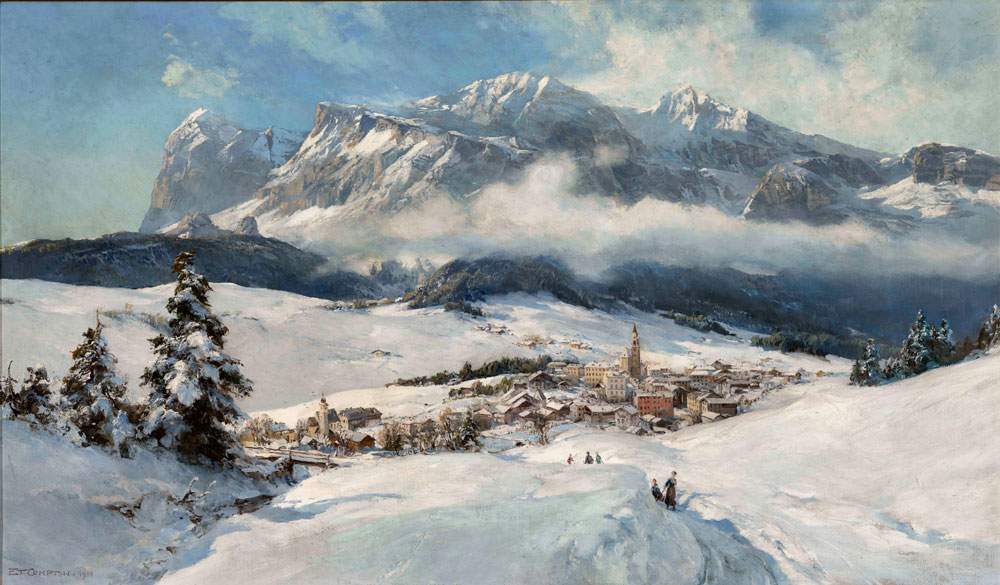Palazzo Sarcinelli in Conegliano presents from March 6 to July 5, 2020 the exhibition Il Racconto della Montagna nella pittura tra Ottocento e Novecento, curated by Giandomenico Romanelli and Franca Lugato.
The aim of the exhibition is to delve into the theme of mountains, which began to provoke a certain fascination in Italy and Europe between the nineteenth and twentieth centuries: in fact, the first climbs, the interests of painting, publicity, cartography, and the first volumes and studies date back to that period.
On display will be works by artists who frequented the Dolomites in particular, from Guglielmo Ciardi to Edward Theodore Compton, from Francesco Sartorelli to Giovanni Napoleone Pellis, from Teodoro Wolf Ferrari to Traiano Chitarin: masterpieces from private and public collections, such as the Istituto Veneto di Scienze, Lettere ed Arti in Venice, the Casa Cavazzini-Museo di Arte Moderna e Contemporanea in Udine, and the Moderna Galleria in Zagreb. Alongside Ugo Fiumiani ’s best-known works depicting snow-capped peaks and expanses, a series dedicated to interpreting the bowels of the mountain will be on view, with some previously unseen visions of the Karst: scenic caves, underground rivers, stalactites, deep waters. In Gabriel Jurkic ’s paintings, on the other hand, there is an effect of silent suspension, which contributed to the birth and development of Croatian modernism.
In addition to the paintings, a selection of publicity, cartography, volumes, and prints will be exhibited to testify to the fortune and growing appeal of the mountain theme already in the second half of the 19th century. The first book dedicated to the exploration of the Dolomites will open the exhibition: it is The Dolomite Mountains, published in 1864, written and illustrated by two British travelers, Josiah Gilbert and George Cheetham Churchill. The Bel Paese by Abbot Antonio Stoppani, published in 1876, was a true best seller, in which the author invited readers to become aware of the country’s natural heritage.
Particular attention will be paid to the rediscovery of the figure of Giuseppe Mazzotti, art critic, writer and essayist: in his La montagna presa in giro, Mazzotti foreshadowed the fear of unbridled tourism, observing the new customs and recent liturgies around the mountains and ironically denouncing the holiday cravings that pollute beauty. Unmissable attention is given to the first female mountaineers, represented by Irene Pigatti, among the first Italian mountaineers in the Dolomites at a time when climbers were in the majority foreigners.
Enriching the narrative of winter sports advertising are posters from the Salce collection in Treviso that date from the early decades of the 20th century, particularly Franz Lenhart ’s works focused on the Dolomites and Cortina.
The last section of the exhibition will tell the story of Napoleone Cozzi, one of the earliest interpreters of unguided mountaineering in the Dolomites and a precursor of sport climbing in Trieste: there will be three notebooks reproducing with delicate watercolors the high routes he traveled during the explorations he made with his flying team.
The exhibition is sponsored by the City of Conegliano and Civita Tre Venezie, with the patronage of the Veneto Region and the Cortina 2021 Foundation, and the collaboration of the CAI section of Conegliano and the Giulie Alpine Society of Trieste.
For info: www.mostramontagna.it
Image: Edward Theodore Compton, Cortina (Treviso, private collection).
 |
| Mountains told in paintings between the 19th and 20th centuries. An exhibition in Conegliano |
Warning: the translation into English of the original Italian article was created using automatic tools. We undertake to review all articles, but we do not guarantee the total absence of inaccuracies in the translation due to the program. You can find the original by clicking on the ITA button. If you find any mistake,please contact us.